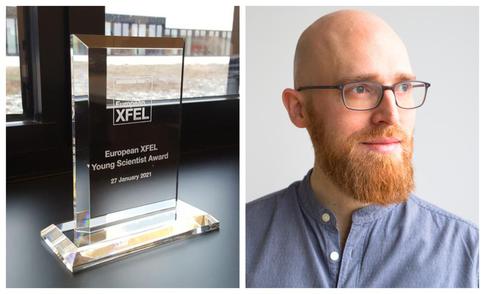XFEL: The first European XFEL Young Scientist Award
The first European XFEL Young Scientist Award

Michael Schneider, the first European XFEL Young Scientist Award recipient. Copyright: European XFEL
Michael Schneider has received the newly established European XFEL Young Scientist award. Schneider, who is a scientist at the Max Born Institute has worked on several experiments at European XFEL’s Spectroscopy and Coherent Scattering (SCS) instrument since the start of its user operation. “We selected Michael Schneider as the first European XFEL “Young Scientist Award” recipient in recognition of his excellent research focused on ultrafast magnetization dynamics that was a part the user program at the SCS Instrument," says one of the European XFEL scientific directors Serguei Molodtsov.
Schneider gave insights into his research work, the importance of European XFEL for his field and a peek into future directions.
What has been the focus of your research?
In my research, I use soft X-ray radiation to study the properties and dynamics of magnetic textures that form in ferromagnetic thin films. These dynamics are governed by a complex interplay of the charge and spin distribution of the electrons and the atomic positions in the lattice. In experiments, we manipulate these degrees of freedom, e.g., by applying magnetic fields, sending currents through the sample or exciting it with an optical laser) and study the reaction of the sample using soft X-ray scattering and imaging. We are focused on a fundamental understanding of the interactions in our samples, but potential applications include a new generation of magnetism-based solid-state data storage.
I am also interested in the interaction of the soft X-ray radiation with our samples on a more fundamental level. Especially at high-brightness sources such as European XFEL, the large number of photons meant to probe the sample may well disturb it to such an extent, that the actual experiment is compromised - even without obvious signs such as permanent damage. Here, I'm interested in finding safe limits for the number of photons per unit time and area and understanding the mechanisms responsible.
What is the importance of European XFEL in your area of research?
X-rays are an extremely valuable tool for the study of magnetism, as they are able to "see" the magnetization when the correct photon energy is used. At the same time, the short wavelength of the X-rays (mostly about 1.6nm in my work) enables a much higher spatial resolution than would be possible with, for example, visible light or lab-based XUV sources. The European XFEL delivers this radiation in highly intense, very short bursts of about 20 femtoseconds duration, which allows us to follow very fast dynamics.
Could you give some more details about what your talk at the Users’ Meeting was about?
I spoke about an experiment in which we used an optical laser to generate skyrmions in a magnetic thin film. Skyrmions are topological objects that can be tailored (by material engineering) to be very small, stable and highly mobile. This makes them very interesting for data storage applications. In the experiment we were able to show that optical light pulses trigger a phase transition in the magnetic material which results in an efficient and unprecedentedly fast way to generate Skyrmions. The results have just been published in Nature Materials (https://doi.org/10.1038/s41563-020-00807-1).
What future directions do you see for your field?
An exciting next step will be to implement real-space imaging of magnetic textures at SCS. There are already promising efforts in that direction within a community proposal that combines expertise of different groups. This will make it possible to observe the dynamics of individual, nanometer-sized features in a movie-like fashion. This will be a very valuable addition to the information gained on ensemble-averages in scattering experiments, as in the experiments at SCS so far.
